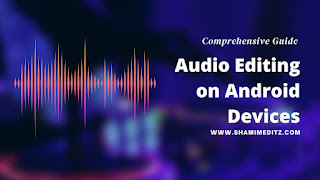Whether you are a professional or just a started, audio editing on an Android device can be a great alternative to traditional desktop software. It offers the benefit of audio editing on the go, and you no longer need to be tied down to a desk. With the right tools and tricks, you can edit and produce high-quality audio content from the comfort of your android smartphone.
In this expensive guide, we will cover everything you need to know about audio editing on Android devices, from selecting the right tools to mastering the advanced tricks.
1. Select the Right Tools/Apps
- Ease of use: Choose an app that is user friendly and easy to use for beginners.
- Features: Make sure the app has the features you need, such as cut, copy, paste, and trimming options.
- Quality of output: Ensure that the app produces high-quality output and that it is balanced with other apps and devices.
- Price: Consider the cost of the app and whether it is worth the investment.
- Audacity: Audacity is one of the most popular audio editing apps for Android phones. It's a free, open-source app that offers a wide range of audio editing tools, including the ability to record, cut, copy, paste, and mix audio. With its simple and intuitive interface, Audacity makes it easy for users to get started with audio editing.
- WavePad: WavePad is another popular audio editing app for Android phones. It offers a wide range of audio editing tools, including the ability to record, cut, copy, paste, and mix audio. It also has a comprehensive set of effects and filters, including equalization, compression, and noise reduction.
- FL Studio Mobile: it is a popular audio editing app for Android phones, particularly among musicians and producers. It offers a wide range of tools for creating and editing music, including a virtual instrument library, sequencing, and mixing tools. With its user-friendly interface, FL Studio Mobile is easy to use, even for those who are new to audio editing.
- n-Track Studio: n-Track Studio is a powerful audio editing app for Android, offering a wide range of tools for recording, editing, and mixing audio. It has a user-friendly interface and supports multitrack recording, allowing you to record and edit multiple tracks at once.
- PowerDirector Video Editor App: It is a best video editing app for Android phones that also includes powerful audio editing tools. With its user-friendly interface and wide range of tools, PowerDirector makes it easy to edit and enhance audio, as well as video content.
Note That: All apps are available on google play store. You can easily install all of app from play store.
2. Recording High-Quality Audio
- Use a high-quality external microphone: The built-in microphone on most Android devices is not the good quality, so consider to using a external microphone to improve the sound quality of your recordings.
- Find a noise free location: Find a noise free location to record your audio to minimize background noise.
- Set the audio level: Make sure you set the audio level to avoid clipping.
- Record in a lossless format: If possible, record your audio in a lossless format such as (WAV or FLAC) to keep up the quality of the audio.
3. Basic Editing Techniques
Once you have recorded your audio, you can start editing on it. Here are some basic audio editing tips and tricks that you can use to improve the quality of your audio:- Trimming: Trimming is the process of cutting out unwanted sections of audio.
- Cutting: Cutting is similar to trimming, but it involves splitting the audio in a separate clips.
- Copy and Paste: Copy/past allows you to duplicate sections of audio and place them on the other hand in the recording.
- Volume adjustment: You can adjust the volume of the audio to make it louder or quieter.
- Fade in and fade out: You can use fade in and fade out effects to smooth the transition between a audio clips.
4. Advanced Editing Techniques
- Compression and Equalization: Compression and equalization are essential for improving the overall quality of your audio. Compression can be used to even out the volume levels and reduce background noise, while equalization can be used to adjust the balance of frequency levels.
- Noise Reduction: If your audio contains unwanted background noise, you can use noise reduction tools to remove it.
- De-verb: If your audio contains unwanted reverb, you can use de-verb tools to remove it. This can be specially useful for recordings made in large spaces.
- Automation: Automation allows you to program changes in the audio over time, such as adjusting the volume or equalization levels.
- Effects: There are many effects that you can add to your audio, such as echo, reverb, chorus, and delay, to enhance its overall sound of your audio.
5. Mixing and Mastering
Here are some tips to help you mix and master your audio:
- Use a reference track: Use a reference track as a guide for your mixing and mastering process to ensure that your audio sounds similar to other professional recordings.
- Use metering tools: Use metering tools to monitor the levels and balance of your audio, and make adjustments as necessary.
- Use a limiter: Use a limiter to prevent audio clipping and distortion.
- Listen to your audio on multiple systems: Listen to your audio on multiple systems, such as speakers, headphones, and car audio systems, to ensure that it sounds good on all devices.

.webp)
.webp)
.webp)
.webp)